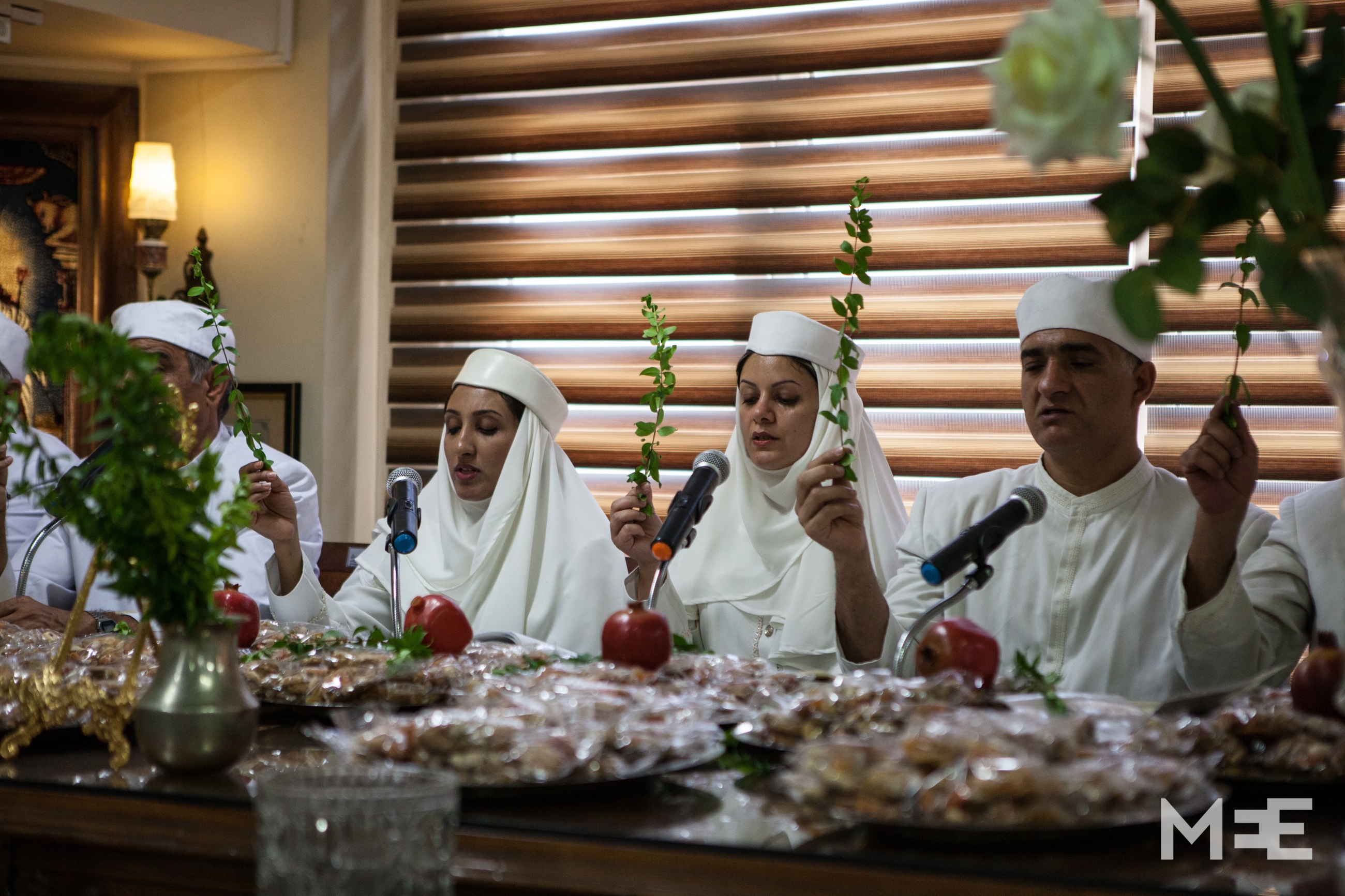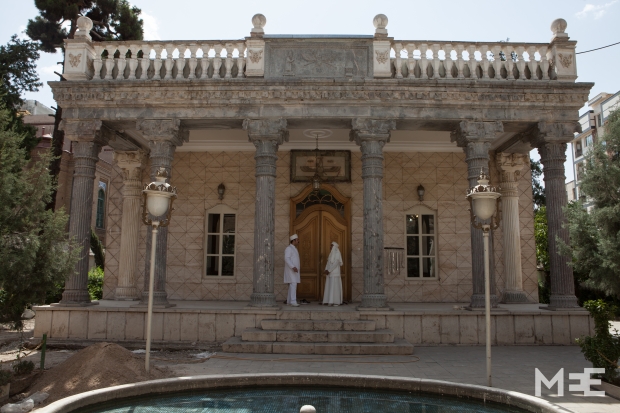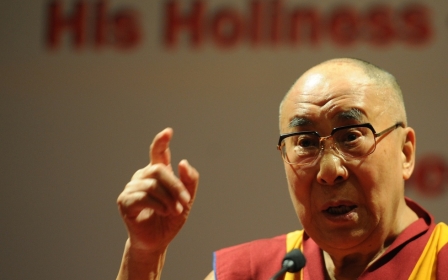The Zoroastrian priestesses of Iran

Viewed from the air, Tehran appears as a pool of scattered bricks and fragments. Near Ferdouzi street, in the south of the capital, sits one of the largest and most emblematic religious complexes of the Zoroastrian minority scattered across Iran. Daily services are held in the fire temple and a ceremony hall, where the Council of the Mobeds (Zoroastrian priests) meets.
Founded by the Prophet Zoroaster around 3,500 years ago, the religion claims around 190,000 followers. The official religion in Iran for 1,000 years, its adherents are now a dwindling minority within the Islamic Republic.
Middle East Eye paid a visit to their fire temple (or Agiary), the site of daily services led by Zorastrian priests. MEE's visit coincided with the third Gambahar, one of the six annual festivals designed to celebrate the creation of the Earth.
Mobediar Sarvar Talapolevara enters the temple dressed in a long white dress on top of which a white veil is pinned, and sits close to the small but vigorous fire that crackles in the middle of the temple.
Talapolevara’s immaculate threads are transcendentally laundered, flawless white throughout. Her one accessory is the traditional koshti, a long belt which represents the Zoroastrian basic principles of “good thoughts, good words and good actions”.
“My father was a Parsi, that is a Zoroastrian from India,” she says. “I recall him fastening his belt every day before breakfast and telling us about his childhood in India, where Zoroastrians cling to conservative traditions and kids must wear the koshti from the age of eight years old.”
“It was my father who encouraged me the most. At first Indian Parsis opposed the idea of the female priests,” Mobed Talapolevara said. “That’s why I was pleasantly surprised upon my initiation as a priest four years ago to receive messages of support from those same Indian Parsi. They even published articles in Indian newspapers and at the International Congress of Zoroastrians."
Behrad, a young Zoroastrian disciple, who chants by heart the Avesta, the holy Zoroastrian scriptures, as often as he can, told MEE that “Zoroastrian society maintains a caste system. The Mobeds are the highest caste. After the Arab invasion and the following persecutions, the majority of Mobeds fled to India”.
“They were the most traditional ones, those who apply the Sasanian interpretation of the sacred text, the Avesta. Actually, during the Sasanian time – the last pre-Islamic reign in Iran – the Mobeds took power and mixed religion and politics together, instituting even a kind of Sharia, a law and moral code which gave the precepts and the rules founded on a new reinterpretation of the Zarathustra recitations.”
Behrad continued: "After the Arab invasion and the abolition of the caste system, the Mobeds, who were supporting the caste system, took refuge in India. Therefore the majority of Indian Parsi are still now Mobeds."
In Iran, the story is different, he said.
“After the ’79 revolution, the Zoroastrian population diminished considerably. In many remote villages, no Mobeds were left, and for this reason the figure of 'mobediars', or priest assistants, started to grow.”
“It was in 2009 that Mobed Soroushpur raised the idea of female priests at the Mobeds’ Council in Tehran,” Behrad told MEE.
Mobed Soroushpur, president of the council, wearing white clothes for the ceremony, said: “During my research, I was digging deep into the archives, and I found out that the school for priests accepted both women and men. I simply thought that I had the duty to write something about it and show it to the council.”
“Sharia law does not belong to our culture; we believe in the concept of frashkat, which means to refresh and renew our values," Mobed Soroushpur told MEE.
"The concepts of equality have always been at the basis of our culture. In antiquity, there were many female priests, politicians, warriors and this even up to the Sasanian time,” he said.
“But after the Arab invasion, this changed ... Currently we are finally living in a period where the equality of genders is on the top of the agenda. The moment has arrived to revive this tradition under the emblem of the frashkat,” starting from the Mobed Council.
The first wall to be scaled today is the council itself, currently a "closed shop" for men. Since the beginning, the majority of Zoroastrians have welcomed the idea of having women beside men, but not without restrictions.
During MEE's visit, there was a peculiar fascination with menstruation - not unheard of in other monotheistic faiths - with the subject on the top of the agenda.
“The most traditional mobeds insist that women can’t perform the rituals during their period, while they are 'impure,'" Mobed Soroushpur told MEE. "This is the reason for which they cannot become full priests before they are 50 or 60 years old. They can be mobediar, assistants to priests, though.”
Soroushpur himself opposes this idea, which he finds conservative and discriminatory.
For her part, Mobed Rashin Jahangiri, medical doctor and priest of two years, said: “This traditional approach will probably change, because in the Gotah [the equivalent of the Old Testament within the two-part Avesta], nothing is mentioned about the women’s period."
"These are outdated interpretations dating back to the Sasanian time, which we should not forcibly follow in the 21st century,” she said, turning towards the fire.
“Looking after the fire is something that mobediars are prevented from doing. It is a responsibility only mobeds can undertake.”
The fire that burns inside the capital temple was carried here from the cradle of the Zoroastrian religion, Yazd, in southern Iran.
In Yazd, six Zoroastrian temples remain. The unused Towers of Silence stand in the outskirts. It was 50 years ago that the growth of the city saw this site take on the role of a cemetery.
“According to our tradition, the corpse must return to nature as soon as possible, without being polluting by any of the four sacred elements,” said Shanahnaz Shahzadi, a teacher in a school for mobeds.
“The dead bodies would be laid out on a block of stone and metal, in order to expose them to the sun’s rays. The body would be displayed before the vultures. Nitric acid would be used to dissolve any remaining bones.”
“We believe that the nine elements that compose the human being stay with the dead body for three days, before the day of judgement. Then, for 30 years we celebrate yearly funerals and after that any souls, even the damned ones, reunite with God in paradise,” she said.
Despite her advanced age, Shanahnaz rushed along the path leading up the Tower of Silence.
“It was women who kept this religion alive,” she told MEE. “Since the ancient times they have been assisting mobeds during the ceremonies as well as looking after the fire. Even now, the most important part of the ceremonies, such as the preparation of the food, is done by women.”
In Sasanian times and after the Arab invasion, she said, “it became impossible for the women to practice the rituals in public. However, hidden in Zoroastrian neighbourhoods, they continued these practices underground.”
The day before MEE's visit, Mobed Fariba became the first woman to hold the overture ceremony of the Gahambar in the Yazd fire temple.
“When I decided to become a priest," she said, "I did it to show that this religion is opposed to any kind of discrimination.”
“It is mainly the elders who didn’t like the idea of female priests,” Mobed Merhaban Firouzgari said.
A sizeable white moustache adorns his wrinkly smile. He has the air of a child recounting a tale to his parents for which he expects punishment.
“Perhaps male priests are afraid that someone could interfere with their source of income.”
“Despite their poorly hidden opposition, the majority of priests openly celebrated and welcomed the female priests. We firmly believe that this is another step towards the equality of the genders inside Zoroastrianism,” he said, carrying himself royally out of the ceremony hall.
Stay informed with MEE's newsletters
Sign up to get the latest alerts, insights and analysis, starting with Turkey Unpacked
Middle East Eye delivers independent and unrivalled coverage and analysis of the Middle East, North Africa and beyond. To learn more about republishing this content and the associated fees, please fill out this form. More about MEE can be found here.








